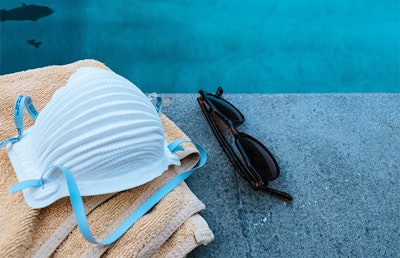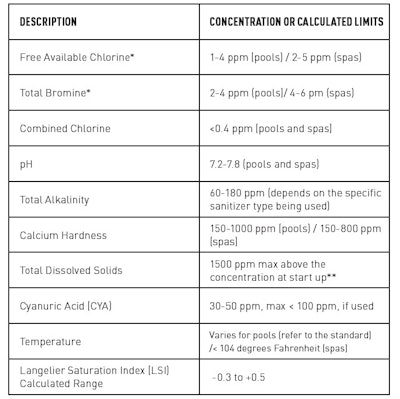
Since the SARS-COV-2 pandemic began, many public and commercial pools were required to adjust to the current situation by putting in place certain safety practices, such as maintaining distance between swimmers, disinfecting surfaces on a regular basis and wearing face coverings where necessary, based on the U.S. Centers for Disease Control and Prevention (CDC) guidelines. To protect the health of both bathers and staff, it was necessary to make sure proper pool water sanitation and disinfection protocols were in place to limit the spread of the coronavirus.
The current understanding indicates the virus is spread by respiratory droplets. When someone inhales the droplets, the virus enters the upper respiratory tract and may cause infection. Based on other similar viruses, infection commonly occurs when two people are physically within 6 feet of each other. More recent data has shown that time spent in the proximity to infected people is also a key factor in disease transmission. Additionally, it is possible that if respiratory droplets land on surfaces or objects, which are then touched by someone who then touches their own mouth, nose or eyes, an infection may occur. Transmission of the virus from contaminated surfaces is not the primary way the virus spreads. Information on the SARS-CoV-2 virus and the COVID-19 disease is changing rapidly.
The most reliable source of information is the U.S. CDC., who has stated that "there is no evidence that the virus that causes COVID-19 can be spread to people through the water in pools, hot tubs, spas or water playgrounds or other treated aquatic venues."
RELATED: Pool and Hot Tub Reopening Guidance
Proper operation and maintenance (including disinfection with chlorine and bromine) of these facilities should inactivate the virus in the water. More information about how to open and maintain the pool facilities can be found in a PHTA article published in AQUA Magazine entitled "Operating Guidelines for a Successful Public Pool and Spa Re-Opening During the COVID-19 Pandemic."
This article provides information on recommended steps to maintain a hygienic environment to control the spread of the virus that causes COVID-19 by maintaining appropriate pool water sanitation in order for swimmers to enjoy their experience.
GENERAL DESCRIPTION
SANITIZER DEFINITION
When it comes to pools and recreational water quality, the term "sanitizer" is used more often than "disinfectant." These terms are used interchangeably because the term "disinfection" is also used in municipal water treatment systems where the goal is to eliminate most of the microorganisms in the water. However, there are differences between municipal water treatment disinfection standards and pool sanitation standards. These sanitizers are registered by the U.S. EPA to be used in recreational water facilities and settings.
DISINFECTANT DEFINITION
Disinfection refers to the practice
of destroying or irreversibly inactivating most of the bacteria and microorganisms in water and on surfaces. This term is mostly used for surface disinfection and municipal water treatment, and it does not apply in swimming pool water treatment, but disinfection has been used interchangeably with sanitizer in the industry. In summary, disinfectants kill more germs than sanitizers.
MAINTAINING APPROPRIATE SANITATION IN POOLS AND SPAS
Maintaining sanitary conditions in pools and spas to protect the public health could be achieved by following the CDC's recommendations and industry-accepted guidelines outlined in ANSI/APSP/ICC-11 2019 American National Standard for Water Quality in Public Pools and Spas, PHTA, 2019. This standard covers all aspects of maintaining pool and spa water from the use of an appropriate EPA-registered sanitizer to water balance and much more. The below table summarizes some of the acceptable concentration and calculated limits outlined in the standard.

CAN COVID-19 SPREAD THROUGH POOLS, HOT TUBS, SPAS AND WATER PLAYGROUNDS?
The U.S. CDC has not taken a position on whether aerosolizing water features, such as hot tubs, spas and water playgrounds, are likely to transmit SARS- CoV-2 by aerosolized droplets. Proper operation and maintenance (including disinfection with chlorine and bromine) of these aquatic facilities should inactivate the virus in the water.
SOCIAL DISTANCING – CUSTOMERS
Since the virus can be transmitted through respiratory droplets, it is imperative to maintain social distancing in the pool while swimming. Properly sanitized pool water will only protect the swimmers to the extent that the virus will not survive in the water, but swimmers in close contact with each other (within 6 feet) while swimming in the pool can transmit the virus through air and air droplets above the pool water surface. There are some guidelines suggesting to only utilize 50% of the pool capacity to ensure swimmers' separation.
HYGIENE
- Require infection control practices, such as regular handwashing, coughing and sneezing etiquette, and proper tissue usage and disposal.
- Encourage employees and customers to engage in repeated handwashing/ sanitization throughout the day and while they are at the facility.
- Provide sanitization materials, such as hand soap, hand sanitizer with at least 60% alcohol and sanitizing wipes, to employees and customers.
PREVENTION & PRECAUTIONS
The following guidelines in the pool while swimming are recommended to prevent the spread of the virus to others:
- Avoid close contact (within 6 feet) with people while swimming in the pool.
- Avoid touching your eyes, nose and mouth.
- Ensure that the number of swimmers in each lane allows adequate physical distance (at least 6 feet) between swimmers.
- Monitor swimmers to discourage huddling at the ends of the lanes during practice or while swimming laps.
- During competition, have swimmers wait at least 6 feet apart behind the starting blocks. Have only one heat behind blocks at a time to eliminate crowding.
- Cover your cough or sneeze with your hands to prevent the spread of airborne droplets to others.
- Wear your face covering when not swimming in the pool and maintain your distance from others.
- Wash your hands often with soap and water for at least 20 seconds, especially after going to the bathroom; before eating; and after blowing your nose, coughing or sneezing.
- If soap and water are not readily available, use an alcohol-based hand sanitizer with at least 60% alcohol. Always wash hands with soap and water if hands are visibly dirty.
- When cleaning surfaces, be sure to allow the sanitizing agent to sit on the surface for a sufficient time to kill the virus. Most cleaners and sanitizers do not kill immediately. Most take two to five minutes of "contact time" to do that killing. The best policy is to spray the solution on the surface and allow it to air dry. All products have specific use directions on the label that should be followed.
REFERENCES
Guidance for Public Pools, Hot Tubs, and Water Playgrounds During COVID-19, U.S. Centers for Disease Control and Prevention website, 2021. Available at: https://www.cdc.gov/ coronavirus/2019-ncov/community/parks-rec/ aquatic-venues.html
"Operating Guidelines for a Successful Public Pool and Spa Re-Opening During the COVID-19 Pandemic" by PHTA Recreational Water Quality Committee, AQUA, March 2021. Available at: https://www.phta.org/standards- and-codes/fact-sheets/tech-notes/
ANSI/APSP/ICC-11 2019 American National Standard for Water Quality in Public Pools and Spas, PHTA, 2019.
U.S. Environmental Protection Agency (EPA) List N: Disinfectants for Coronavirus (COVID-19) (for use on surfaces). Available at: https://www.epa.gov/pesticide-registration/list- n-disinfectants-coronavirus-covid-19
SUMMARY
|
This article first appeared in the April 2021 issue of AQUA Magazine — the top resource for retailers, builders and service pros in the pool and spa industry. Subscriptions to the print magazine are free to all industry professionals. Click here to subscribe.











































